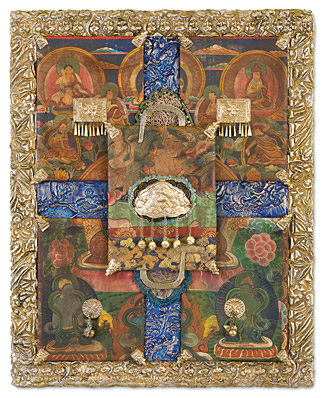Title: “SAMMA”
(Meaning, “our very best” in Pali
and pronounced, “sah-mah”)


|
Size: 34.25” W x 30.25” H
(unframed)
Story:
The fourth noble truth of Buddhism is the Way leading to the end of suffering and can be achieved by following the Noble Eightfold Path. It was this empowerment of the individual and non-reliance on an established clergy that allowed Buddhism to migrate across the Himalayas and spread throughout China. It offered the opportunity that whether you were a peasant, middle class or a noble, by following a code of behavior and thought you could transcend suffering, and at the very core of this belief was that one must do their best. A noble quest. A heavenly reward.
Materials:
Mid-1800’s Chinese silver repousse medallion with auspicious symbols, resting on early 1800’s Chinese embroidery from a child’s “mouse” hat, resting on late 1800 Tibetan thangka cloth with two early 1800’s silver forged hardware pieces from a Japanese Buddhist temple screen, with four surrounding panels of mid-1800’s Tibetan thankga cloth depicting Indra and subsidiary gods, with silver medallions and images of Buddha from four mid-1800’s Tibetan silver inlaid children’s hats, all resting on wooden museum panel covered with sculpted Yixing plaster with impressions made using 17th -18th century Chinese and Japanese fabric stamps, then painted and gilded and hand-rubbed with silver paint.
|
|
|
|
Click for enlarged
section of art.
|
Click for enlarged
section of art.
|
|